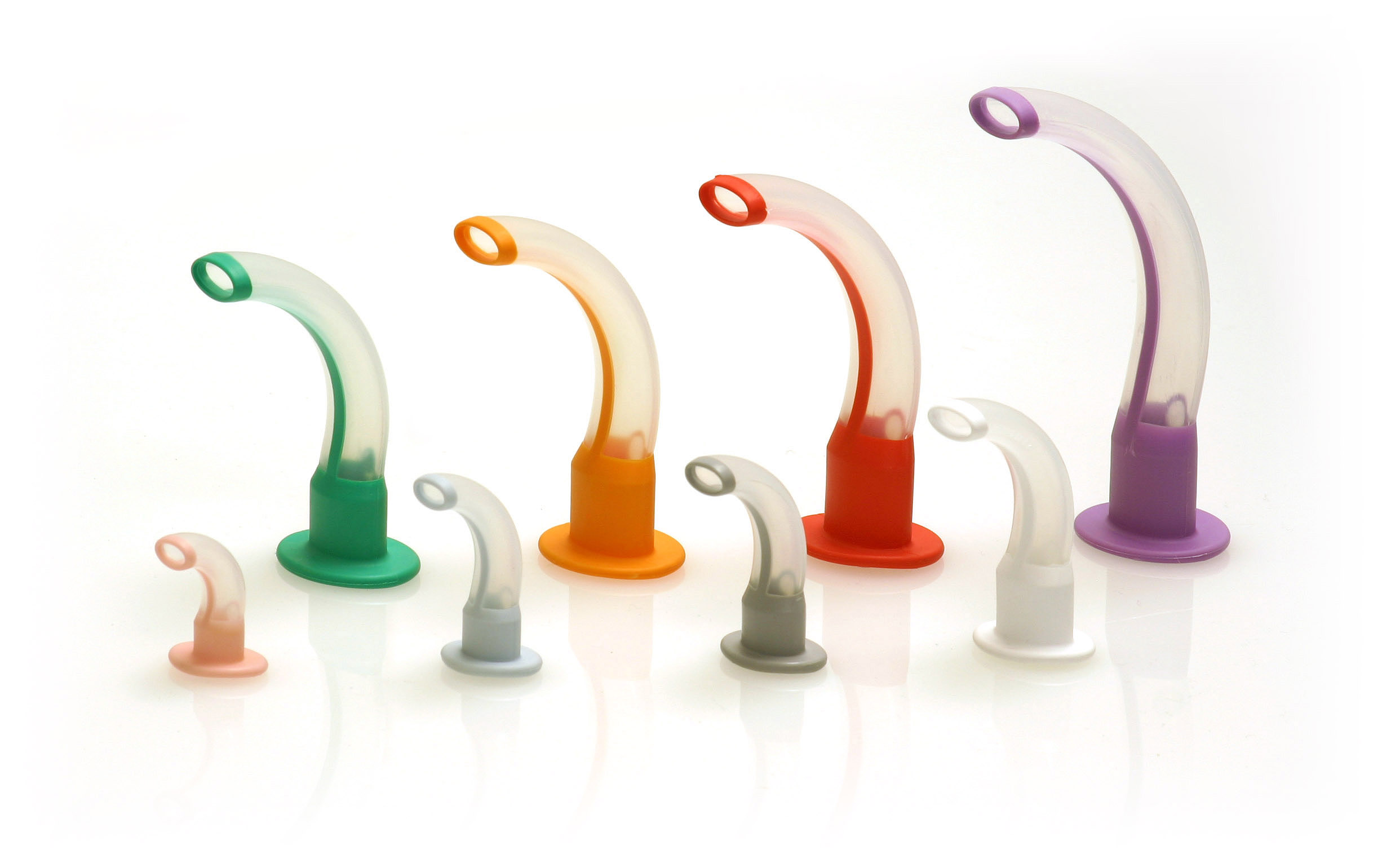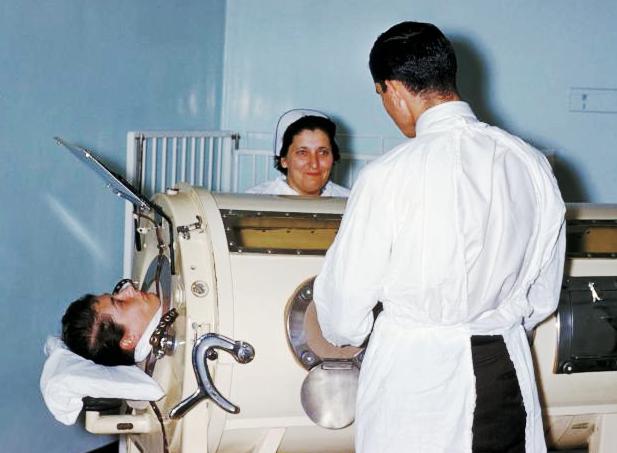|
Combitube
The Combitube—also known as the esophageal tracheal airway or esophageal tracheal double-lumen airway—is a blind insertion airway device (BIAD) used in the pre-hospital and emergency setting.Jorge E. Zamora and Tarit K. Saha,Combitube rescue for cesarean delivery followed by ninth and twelfth cranial nerve dysfunction Canadian Journal of Anesthesia Volume 55, Issue 11 , pp 779-784, published 2008 It is designed to provide an airway to facilitate the mechanical ventilation of a patient in respiratory distress. Description and use It consists of a cuffed, double-lumen tube that is inserted through the patient's mouth to secure an airway and enable ventilation. Generally, the distal tube (tube two, clear) enters the esophagus, where the cuff is inflated and ventilation is provided through the proximal tube (tube one, blue) which opens at the level of the larynx. In the rare instance where the distal tube intubates the trachea, ventilation is provided through the distal tube. In ... [...More Info...] [...Related Items...] OR: [Wikipedia] [Google] [Baidu] |
Endotracheal Intubation
Tracheal intubation, usually simply referred to as intubation, is the placement of a flexible plastic tube into the trachea (windpipe) to maintain an open airway or to serve as a conduit through which to administer certain drugs. It is frequently performed in critically injured, ill, or anesthetized patients to facilitate ventilation of the lungs, including mechanical ventilation, and to prevent the possibility of asphyxiation or airway obstruction. The most widely used route is orotracheal, in which an endotracheal tube is passed through the mouth and vocal apparatus into the trachea. In a nasotracheal procedure, an endotracheal tube is passed through the nose and vocal apparatus into the trachea. Other methods of intubation involve surgery and include the cricothyrotomy (used almost exclusively in emergency circumstances) and the tracheotomy, used primarily in situations where a prolonged need for airway support is anticipated. Because it is an invasive and uncomfortable medi ... [...More Info...] [...Related Items...] OR: [Wikipedia] [Google] [Baidu] |
Blind Insertion Airway Device
A blind insertion airway device (BIAD or blind insertion device) is a medical device used for airway management that ensures an open pathway between a patient's lungs and the outside world, as well as reducing the risk of aspiration, which can be placed without visualization of the glottis. Blind insertion airway devices are often used in the pre-hospital and emergency setting. While the term blind insertion airway device does not refer to an endotracheal tube, it too can also be blindly inserted in certain circumstances, or inserted using a BIAD as a conduit for an endotracheal tube, or by using a bougie or airway exchange catheter. Blind insertion devices have a number of limitations compared to endotracheal intubation, firstly the risk of aspiration is higher when using a blind insertion device. Examples of blind insertion airway devices are: * Combitube * Laryngeal tube * Laryngeal mask airway * Nasopharyngeal airway * Oropharyngeal airway Additional images Image:Comb ... [...More Info...] [...Related Items...] OR: [Wikipedia] [Google] [Baidu] |
Airtraq
Airtraq is a fibreoptic intubation device used for indirect (video or optic assisted) tracheal intubation in difficult airway situations. It is designed to enable a view of the glottic opening without aligning the oral with the pharyngeal, and laryngeal axes as an advantage over direct endotracheal intubation and allows for intubation with minimal head manipulation and positioning.D. Gravenstein, S. LampotangAIRTRAQ Laryngoscope''University of Florida Department of Anesthesiology'', 2 July 2011, retrieved 2 July 2013 Description Airtraq was developed by Pedra A. Gandarias and produced and marketed by Prodol Meditec S.A., Vizcaya, Spain. The standard Airtraq is a disposable article with an eyepiece optic, while the AirtraqAvant allows re-use of the optical system as well as external video monitoring and recording. The Airtraq blade is anatomically formed, with a battery-powered light source at the tip of the blade. The battery power reserve is sufficient to power the bulb fo ... [...More Info...] [...Related Items...] OR: [Wikipedia] [Google] [Baidu] |
Laryngeal Mask
A laryngeal mask airway (LMA), also known as laryngeal mask, is a medical device that keeps a patient's airway open during anaesthesia or while they are unconscious. It is a type of supraglottic airway device. They are most commonly used by anaesthetists to channel oxygen or inhalational anaesthetic to the lungs during surgery and in the pre-hospital setting (for instance by paramedics and emergency medical technicians) for unconscious patients. A laryngeal mask is composed of an airway tube that connects to an elliptical mask with a cuff which is inserted through the patient's mouth, down the windpipe, and once deployed forms an airtight seal on top the glottis (unlike tracheal tubes which pass through the glottis) allowing a secure airway to be managed by a health care provider. The laryngeal mask was invented by British anaesthesiologist Archibald Brain in the early 1980s and in December 1987 the first commercial laryngeal mask was made available in the United Kingdom. The l ... [...More Info...] [...Related Items...] OR: [Wikipedia] [Google] [Baidu] |
Laryngeal Mask Airway
A laryngeal mask airway (LMA), also known as laryngeal mask, is a medical device that keeps a patient's airway open during anaesthesia or while they are unconscious. It is a type of supraglottic airway device. They are most commonly used by anaesthetists to channel oxygen or inhalational anaesthetic to the lungs during surgery and in the pre-hospital setting (for instance by paramedics and emergency medical technicians) for unconscious patients. A laryngeal mask is composed of an airway tube that connects to an elliptical mask with a cuff which is inserted through the patient's mouth, down the windpipe, and once deployed forms an airtight seal on top the glottis (unlike tracheal tubes which pass through the glottis) allowing a secure airway to be managed by a health care provider. The laryngeal mask was invented by British anaesthesiologist Archibald Brain in the early 1980s and in December 1987 the first commercial laryngeal mask was made available in the United Kingdom. Th ... [...More Info...] [...Related Items...] OR: [Wikipedia] [Google] [Baidu] |
Laryngeal Tube
The laryngeal tube (also known as the King LT) , ''University of Toronto, Department of Anesthesia'' Website retrieved 21 May 2013 is an airway management device designed as an alternative to other airway management techniques such as mask ventilation, , and . This device can be inserted blindly through the |
Mechanical Ventilation
Mechanical ventilation, assisted ventilation or intermittent mandatory ventilation (IMV), is the medical term for using a machine called a ventilator to fully or partially provide artificial ventilation. Mechanical ventilation helps move air into and out of the lungs, with the main goal of helping the delivery of oxygen and removal of carbon dioxide. Mechanical ventilation is used for many reasons, including to protect the airway due to mechanical or neurologic cause, to ensure adequate oxygenation, or to remove excess carbon dioxide from the lungs. Various healthcare providers are involved with the use of mechanical ventilation and people who require ventilators are typically monitored in an intensive care unit. Mechanical ventilation is termed invasive if it involves an instrument to create an airway that is placed inside the trachea. This is done through an endotracheal tube or nasotracheal tube. For non-invasive ventilation in people who are conscious, face or nasal mask ... [...More Info...] [...Related Items...] OR: [Wikipedia] [Google] [Baidu] |
Laryngeal Tube
The laryngeal tube (also known as the King LT) , ''University of Toronto, Department of Anesthesia'' Website retrieved 21 May 2013 is an airway management device designed as an alternative to other airway management techniques such as mask ventilation, , and . This device can be inserted blindly through the |
Endotracheal Tube
A tracheal tube is a catheter that is inserted into the trachea for the primary purpose of establishing and maintaining a patent airway and to ensure the adequate exchange of oxygen and carbon dioxide. Many different types of tracheal tubes are available, suited for different specific applications: * An endotracheal tube is a specific type of tracheal tube that is nearly always inserted through the mouth (orotracheal) or nose (nasotracheal). * A tracheostomy tube is another type of tracheal tube; this curved metal or plastic tube may be inserted into a tracheostomy stoma (following a tracheotomy) to maintain a patent lumen. * A tracheal button is a rigid plastic cannula about 1 inch in length that can be placed into the tracheostomy after removal of a tracheostomy tube to maintain patency of the lumen. History Portex Medical (England and France) produced the first cuff-less plastic 'Ivory' endotracheal tubes. Ivan Magill later added a cuff (these were glued on by hand to mak ... [...More Info...] [...Related Items...] OR: [Wikipedia] [Google] [Baidu] |
Endotracheal Tube
A tracheal tube is a catheter that is inserted into the trachea for the primary purpose of establishing and maintaining a patent airway and to ensure the adequate exchange of oxygen and carbon dioxide. Many different types of tracheal tubes are available, suited for different specific applications: * An endotracheal tube is a specific type of tracheal tube that is nearly always inserted through the mouth (orotracheal) or nose (nasotracheal). * A tracheostomy tube is another type of tracheal tube; this curved metal or plastic tube may be inserted into a tracheostomy stoma (following a tracheotomy) to maintain a patent lumen. * A tracheal button is a rigid plastic cannula about 1 inch in length that can be placed into the tracheostomy after removal of a tracheostomy tube to maintain patency of the lumen. History Portex Medical (England and France) produced the first cuff-less plastic 'Ivory' endotracheal tubes. Ivan Magill later added a cuff (these were glued on by hand to mak ... [...More Info...] [...Related Items...] OR: [Wikipedia] [Google] [Baidu] |
European Resuscitation Council
The European Resuscitation Council (ERC) is the European Interdisciplinary Council for Resuscitation Medicine and Emergency Medical Care Emergency medicine is the medical speciality concerned with the care of illnesses or injuries requiring immediate medical attention. Emergency physicians (often called “ER doctors” in the United States) continuously learn to care for unsche .... It was established in 1989. The ERC's objective is "To preserve human life by making high quality resuscitation available to all". The ERC is the network of National Resuscitation Councils in Europe. Chair of the ERC is Koen Monsieurs. References External linksOfficial site Emergency medicine organisations Organizations established in 1989 International medical associations of Europe {{med-org-stub ... [...More Info...] [...Related Items...] OR: [Wikipedia] [Google] [Baidu] |
American Heart Association
The American Heart Association (AHA) is a nonprofit organization in the United States that funds cardiovascular medical research, educates consumers on healthy living and fosters appropriate cardiac care in an effort to reduce disability and deaths caused by cardiovascular disease and stroke. Originally formed in New York City in 1924, it is currently headquartered in Dallas, Texas. The American Heart Association is a national voluntary health agency. They are known for publishinguidelineson cardiovascular disease and prevention, standards on basic life support, advanced cardiac life support (ACLS), and pediatric advanced life support (PALS), and in 2014 issued its first guidelines for preventing strokes in women. They are known also for operating a number of highly visible public service campaigns starting in the 1970s, and also operate a number of fundraising events. In 1994, the ''Chronicle of Philanthropy'', an industry publication, released a study that showed the American H ... [...More Info...] [...Related Items...] OR: [Wikipedia] [Google] [Baidu] |




